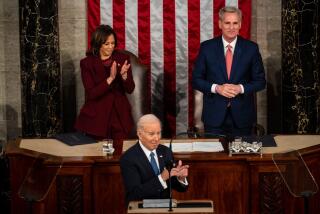For Healthy Economy, Extend Budget Cuts Years Ahead
- Share via
Make no mistake, the federal budget deficit was the fundamental cause of the recent stock market crash.
The continuing need to attract foreign capital to finance the deficit has led directly to real interest rates that are far above their traditional levels. In recent months, as foreign investors became reluctant to continue their purchase of U.S. bonds, the Federal Reserve came under pressure to raise interest rates further in order to slow the dollar’s decline.
In the end investors’ fears about the future course of interest rates and the dollar played a critical role in triggering the financial crisis.
Despite some recent progress in reducing the deficit, the high long-term real interest rates are evidence that the market believes that a serious budget problem may continue indefinitely. Although the deficit declined sharply to $148 billion in 1987, it is widely recognized that most of the reduction this year was due to special, one-time factors. Even with $23-billion worth of reductions scheduled for next year in the Gramm-Rudman legislation, the 1988 deficit is likely to be significantly higher than $148 billion and could be closer to $200 billion.
The budget problem has been compounded by the increasing reluctance of foreign investors to come up with the capital to finance the deficit. During the past year, private foreign investors stopped being net buyers of U.S. bonds. Without substantial further progress toward eliminating the deficit, the decline in foreign purchases means that future interest rates are bound to rise even more, weakening the already fragile economy.
The best way to restore confidence in the economy--and therefore in the stock and bond markets--would be to put in place a dependable multi-year deficit-reduction program.
The Federal Reserve is now doing its part to steady the economy by taking confidence-restoring actions to lower short-term interest rates. Without help from Congress and the Administration, however, the Fed’s actions will not be successful.
While many factors contributed to the market collapse, one key element was the fear that the Fed would raise interest rates in order to prevent a further decline of the dollar. But as we and other economists have long argued, a significant decline of the dollar is actually necessary for restoring American competitiveness in international trade. And despite record lows in the dollar’s exchange rates with the yen and the mark, a further decline of about 30% is needed over the next five years to establish and maintain trade balance.
As the recent exchange movements indicate, this decline is likely to be achieved by market forces--unless the Fed succumbs to pressure to raise interest rates sharply. Any such move in the foreseeable future would only precipitate further financial chaos.
The Fed has responded appropriately to the stock market crisis. Now it is time for Congress and the Administration to do their part. With a reliable and gradual multi-year deficit-reduction plan, investor confidence could be restored. The market would follow with reductions in interest rates, and increases in investment for housing and business plant and equipment. Unfortunately, it doesn’t look like there is much chance for such legislation until 1989. Until then, we’ll have to settle for a one- or two-year budget package.
Although some in the Congress and elsewhere are calling for a huge one-shot deficit cut of as much as $50 billion in 1988, the deflationary impact of such a tactic is well known. Thus there is little danger that either party will overlook the risk of a too-heavy-handed deficit-reduction on the short-run health of the economy. The scheduled $23-billion Gramm-Rudman deficit-reduction target for this year strikes us as a reasonable amount if Congress and the Administration cannot agree on a long-term deficit-reduction program.
Far too much attention is being given to the share of taxes in the $23-billion budget package. Although we’re convinced that the long-term budget resolution will have to include increased revenue as well as spending cuts, the precise size of the 1988 revenue increase is of little economic importance.
When Congress and the Administration are ready to enact a multi-year deficit-reduction plan, it will be possible to increase tax revenues in ways that have relatively minor negative effects on the saving and investment that is needed for long-term economic growth.
It’s a pity that the budget negotiation group is spending so much time on the detailed composition of a package for 1988 and not looking at the long-term problem. Apparently the politicians are going to make us wait until 1989 to see if they can produce a credible multiyear deficit reduction plan. But will the financial markets be willing to wait that long?
More to Read
Inside the business of entertainment
The Wide Shot brings you news, analysis and insights on everything from streaming wars to production — and what it all means for the future.
You may occasionally receive promotional content from the Los Angeles Times.










